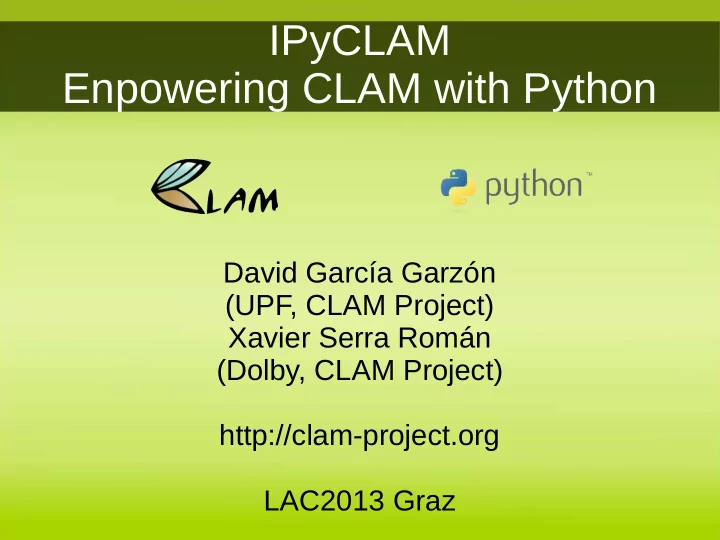

IPyCLAM Enpowering CLAM with Python David García Garzón (UPF, CLAM Project) Xavier Serra Román (Dolby, CLAM Project) http://clam-project.org LAC2013 Graz
Outline ● Introduction to CLAM ● API ● Engines (CLAM, JACK...) ● Prototyping ● Conclusions
The CLAM project ● Born at Universitat Pompeu Fabra, 2001 ● Adopted by Barcelona Media Foundation, 2007 ● Startups, adquisitions by big corporations... ● Team members busy ● Potential contributions won't be released ● Nowadays, it has no support from any parent institution like it had in the past.
Buried? Not entirely!! ● A bunch of developers still push in their spare time. ● Big project, few hands... ● Wanna join?
CLAM
CLAM: building blocks
CLAM: visual prototyping
CLAM: visual prototyping
Why Python? ● Fast development ● Interactive ● But... wasn't Python unsafe for real-time? ● Nevermind, RT code is isolated inside modules ● Let Python play the glue role
How does IPyClam empower CLAM? ● Powerful prototyping language ● PySide/PyQt4 ● Interactive manipulation of networks ● Serialization format ● Parametric networks
A not so complex network
API design goals ● Do not mimic C++ API ● Python expressiveness ● Slices, dynamic attributes, iterators... ● Redundant API: ● Offer the convenient API but also the API that being less convenient cover all cases. ● Interactive use: ● Object discovery by tab completion
Convenience vs. versatility ● Convenient way net.processing1.port1 ● Short and enables tab completion discovery ● Most versatile way net[“processing1”].inports[“port1”] ● Invalid Python identifiers ● Collisions with existing methods/attributes ● Collisions with outports/controls/configs
An example: JACK stereo wire from ipyclam import Network n = Network() n.source = “AudioSource” n.sink = n.types.AudioSink n.source.NSources = 2 n.sink.NSinks = 2 n.source > n.sink n.backend = “JACK” n.play()
Module creation ● Assign a new attribute or item n.newproc = ... n[“newproc”] = ... ● To a string n.newproc = “AudioSource” ● Or to a member of n.types. n.newproc = n.types.AudioSources ● Provides available types by tab completion
Module configuration ● Attribute or item assignment net.myprocessing.parameter = “value” net.myprocessing['parameter'] = “value” net.myprocessing.config.parameter = “value” ● Holding reconfiguration with net.myprocessing.config as c : c.parameter1 = 1000 c.parameter2 = 2000
Connections: Broadcasting ● One to one net.source.outport1 > net.sink.inport1 ● One to many net.source.outport1 > net.sink ● Many to many net.source > net.sink
Connections: Slices ● Connecting intervals net.source[2:7] > net.sink ● Connecting just even ports net.source[::2] > net.sink ● Inverting channel order net.source[::-1] > net.sink
Iterables ● Iterable objects: porttypes = { port.name: port.type for port in net.myproc.outports } ● net.proc.outports ● net.processings ● net.proc.inports ● net.types ● net.proc.outcontrols ● net.proc.port.peers ● net.proc.incontrols ● net.proc.config
Audio backends and transport ● Setting the backend property net.backend = “PortAudio” ● Controling the playback net.play(), net.stop(), net.pause() net.isPlaying(), net.isStopped(), net.isPaused()
Self replicable ● net.code() generates the code needed to regenerate itself. ● Alternative to current XML serialization ● More readable ● Not safe if using the Python interpret!! ● Fast display: If you just type 'net' prints the code.
Integrated console
JACK engine, ¿IPyJack?
How? User API Engine API Pythonic C like Redundant Narrow Stateful Stateless Functional Convenient ● Original intent: decouple syntactic sugar from the code that does stuff. Mock-ups. ● Side effect: Reimplementing the engine API for a different system, like JACK is fast!
PySide/PyQt4 integration
Replicating Prototyper behaviour import QtGui from PySide import ipyclam.ui.PySide as ui app = QtGui.QApplication(sys.argv) net = ipyclam.Network() net.load(“sms.clamnetwork”) w = ui.loadUi(“dialog.ui”) net.bindUi(w) w.show() net.play() app.exec_()
A simple osciloscope ● Creating widgets with Qt factories ● Assigning binding properties: net.source = “AudioSource” w = ui.createWidget(“Oscilloscope”) w.setProperty(“clamOutport”, “source.1”) net.bindUi(w) w.show() ...
Conclusions ● Nice API! ● Reusable for other systems like JACK ● Prototyping: Qt + Python + CLAM ● Integrated console for interactive manipulation and exploration of networks.
Future work ● Fixing NetworkEditor interaction: ● Canvas update. ● Processing placement ● Examples, examples, examples. ● Numpy based audio backend ● Modules in Python for offline processing ● Other engines: gAlan, Patchage...
Questions?
Thanks
Recommend
More recommend